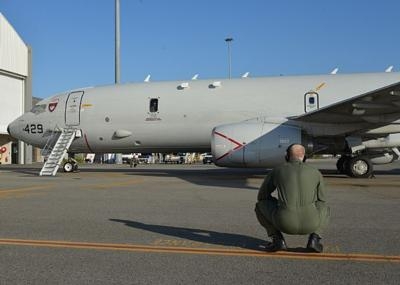Will Join The Efforts Friday After Traveling From Okinawa
In an effort to pinpoint the exact location Malaysian Air MH370 went down in the Indian Ocean, U.S. 7th Fleet is sending a second P-8 Poseidon Patrol aircraft to Perth, Australia to aid in the search efforts.

The P-8 will fly from Okinawa, Japan to Perth March 28 to join an international coalition of search aircraft being coordinated by the Australian Defense Force.
"It's critical to continue searching for debris so we can reverse-forecast the wind, current and sea state since March 8th to recreate the position where MH370 possibly went into the water. We've got to get this initial position right prior to deploying the Towed Pinger Locator since the MH370's black box has a limited battery life and we can't afford to lose time searching in the wrong area," said Cmdr. Tom Moneymaker, U.S. 7th Fleet oceanographer.
Harsh weather conditions, including ceilings as low as 800 feet and potential icing conditions, make the addition of the all-weather P-8 extremely valuable. In total, 7th Fleet patrol aircraft have flown 16 missions, flying more than 150 flight hours covering 220,000 square nautical miles.
In anticipation of finding MH370 debris and pinpointing a close approximation of the crash coordinates, U.S. Pacific Fleet moved a Towed Pinger Locator hydrophone and Bluefin-21 Side-scan sonar into Perth for future positioning to the crash site.
This movement is a prudent effort to preposition equipment and trained personnel closer to the search area so that if debris is found, search coordinators will be able to respond as quickly as possible since the battery life of the black box's pinger is limited.
The P-3 Orion previously searching in the Northern Indian Ocean will return to previously assigned 7th Fleet missions.
In terms of mission effectiveness and reliability, the P-8A represents a leap forward for the Navy's maritime patrol and reconnaissance community. The aircraft has a maximum speed of 490 knots, a ceiling of 41,000 feet, and provides a range of more than 1,200 nautical miles with four hours on station. For a mission such as the MH370 search, the P-8 will typically fly at 5,000 feet at 350 knots, dropping to 1,000 feet to get a visual identification of any radar returns. It may also fly at 1,000 feet for an extended period of the flight, depending on the environment and mission for the flight. It has a search time of approximately eight, nine hours depending on distance to search area, though during this mission the search time on station is greatly reduced due to the distance of the search area from Perth.
The P-8A is the most advanced long range anti-submarine and anti-surface warfare aircraft in the world. A true multi-mission aircraft, it also provides superior maritime intelligence, surveillance and reconnaissance capability. Built on the proven Boeing 737 airframe, the P-8A brings with it enhanced safety and reduced maintenance.
The new P-8A is part of the Navy's commitment to the Pacific rebalance, bringing newer and more capable aircraft to 7th Fleet to ensure the Navy is best postured to honor its security commitments to the Indo-Asia-Pacific and contribute to regional security and stability.
(Image from file)
 ANN's Daily Aero-Linx (05.02.24)
ANN's Daily Aero-Linx (05.02.24) ANN's Daily Aero-Term (05.02.24): Touchdown Zone Lighting
ANN's Daily Aero-Term (05.02.24): Touchdown Zone Lighting Aero-News: Quote of the Day (05.02.24)
Aero-News: Quote of the Day (05.02.24) ANN FAQ: Contributing To Aero-TV
ANN FAQ: Contributing To Aero-TV NTSB Final Report: Cirrus Design Corp SR20
NTSB Final Report: Cirrus Design Corp SR20



